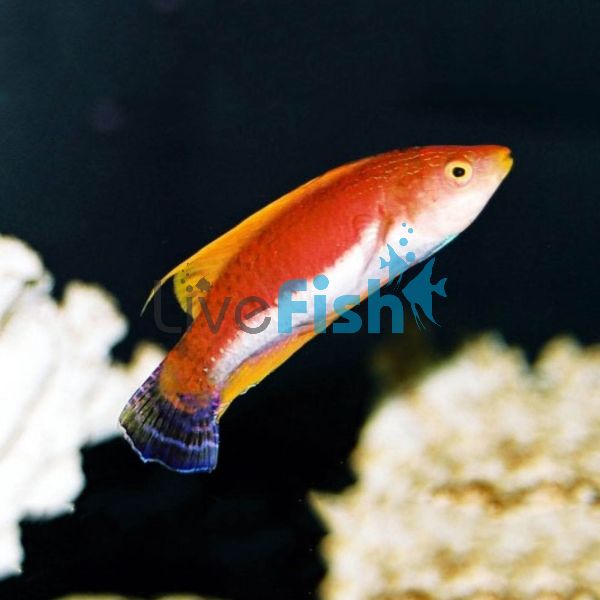Matador Whipfin Fairy Wrasse - Medium
The Whip Fin Fairy Wrasse will bring plenty of colour and activity to your aquarium. It is a peaceful species which is suitable for beginner or experienced aquarists.
The Whip Fin Fairy Wrasse stands out because of its long dorsal fin. This can often extend beyond the length of the fish. The male has a bright red upper body and a white lower half. The dorsal fin is yellow with a blue outline. Females are usually a duller red colour with a black spot at the base of the tailfin. This species can change colour according to moods. Males will use their brightly coloured fin to attract a female during courting.
Breeding information about this species is limited. In general, Fairy Wrasses are protogynous hermaphrodites. There are no reports of juvenile males being spotted in the wild. It is believed that the dominant female in a group will change sex to become male. Spawning starts with courting displays beforehand. The male swims through his harem of females flashing his colours. After selecting a female they will loop and release their gametes at the highest point. "Streak spawning" can also occur. A non-territorial dominant male dashes into a mating pair as they release gametes. He will also release his gametes at the same time.
Their natural environment is the Indo-West Pacific region, including Indonesia and East Timor. They inhabit estuaries or, more commonly, reefs between depths of 10-35 metres.
Tank Recommendations for your Whip Fin Fairy Wrasse
The smallest tank size should be at least 55 gallons (208.2 litres) capacity.
The Whip Fin Fairy Wrasse can be kept in a reef or fish-only tank. A reef tank is most suitable as they don't pose any threat to corals or invertebrates. There should be plenty of live rock with caves and crevices for hiding. They are an active species, so also need areas of open water for swimming.
This species of Wrasse doesn't bury itself in the substrate at night to sleep like many other species. Instead they often form a mucus cocoon around themselves and wedge themselves into a rock crevice.
This species is capable of jumping out of a tank so it is recommended to have a secure fitting lid.
Suitable Tank Buddies
The Whip Fin Fairy Wrasse is generally considered to be a peaceful fish. It can become territorial and aggressive with similar wrasse species.
Avoid certain larger fish which may intimidate it. Some smaller timid fish may get outcompeted at feeding time.
Usually Compatible
Whip Fin Wrasse can be kept with a variety of peaceful tank buddies. Good examples include Tilefish, Fairy Basslets, small Cardinalfish, Butterflyfish, and Gobies.
Sometime Compatible
Conspecifics should consist of a single male and a number of females. Females should be added beforehand as the male can show aggression to new females. Two males should not be kept in the same tank unless it is large enough to avoid any aggression.
Rarely Compatible
Larger aggressive predators such as Lionfish, Frogfish, and Groupers are a threat. Certain species such as larger Tangs or Angelfish may intimidate it. Smaller timid species may get outcompeted for food. This can be an issue for fish such as Dottybacks and slow movers like Seahorses and Pipefish.
Feeding your Whip Fin Fairy Wrasse
The Whip Fin Fairy Wrasse is carnivorous. Suitable food includes vitamin-enriched brine shrimp, mysis shrimp, krill, and plankton. It may also start to eat flake foods over time. It should be fed small amounts of food several times per day.
| Scientific Name | Cirrhilabrus Filamentosus |
|---|---|
| Care Level | Easy |
| Common Names | Whip Fin Fairy Wrasse |
| Diet | Carnivore |
| Fish Family | Labridae |
| Lifespan (years) | 6 |
| Max. Length (cm) | 8 |
| Min. Tank Volume (l) | 208 |
| Origin | Indo-West Pacific; Indonesia, East Timor |
| Reef Safe | Yes |
| Sociability | Peaceful |
| Venomous | No |
| Water Conditions | 22-25° C, dKH 8-12, pH 8.1-8.4, sg 1.020-1.025 |




